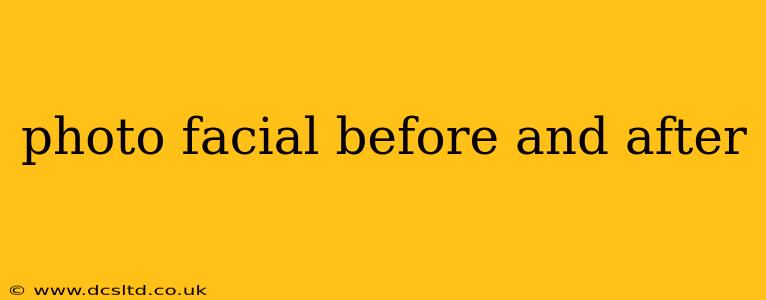A photo facial, also known as intense pulsed light (IPL) therapy, is a popular non-invasive cosmetic procedure that uses broad-spectrum light to rejuvenate the skin. It's a versatile treatment addressing various skin concerns, resulting in a noticeable improvement in skin tone, texture, and overall appearance. This comprehensive guide explores the before-and-after aspects of photo facials, detailing what to expect throughout the process.
What is a Photo Facial?
A photo facial utilizes intense pulsed light (IPL) to target and improve various skin imperfections. The intense light energy penetrates the skin, stimulating collagen production and breaking down unwanted pigmentation and blood vessels. This process leads to a reduction in age spots, sun damage, redness, and fine lines, resulting in brighter, smoother, and more youthful-looking skin.
The treatment is typically performed by a dermatologist or aesthetician in a medical spa or clinic setting. The number of sessions required varies depending on individual skin type, condition, and desired results.
Photo Facial Before and After: What to Expect
The "before" stage involves a consultation with a qualified professional to determine suitability and address any concerns. They'll assess your skin type, condition, and medical history to create a personalized treatment plan. This consultation also includes explaining the procedure, potential side effects, and aftercare instructions.
Before the procedure: You'll be asked to avoid sun exposure and certain medications for a period before the treatment. Your skin might be cleansed, and a topical anesthetic might be applied for increased comfort.
During the procedure, you’ll likely experience a mild snapping or tingling sensation as the light pulses are applied. The treatment time varies depending on the size of the area being treated.
After the procedure: You may experience some redness, swelling, or mild discomfort, which usually subsides within a few hours to a few days. Your skin might feel slightly warmer to the touch. Following your clinician's aftercare instructions diligently is crucial for optimal results and minimizing any potential side effects. This typically involves avoiding sun exposure, using sunscreen with a high SPF, and keeping the treated area clean and moisturized.
The "after" results are gradual, with visible improvements becoming more apparent over several weeks as the skin heals and regenerates. Multiple sessions are often recommended for optimal results, typically spaced several weeks apart.
What are the Benefits of a Photo Facial?
- Improved Skin Tone: Reduces uneven pigmentation, age spots, and sun damage, resulting in a more even skin tone.
- Reduced Redness: Diminishes redness associated with rosacea and broken capillaries.
- Enhanced Skin Texture: Improves skin texture by stimulating collagen production, leading to smoother and firmer skin.
- Minimized Fine Lines and Wrinkles: Reduces the appearance of fine lines and wrinkles, contributing to a more youthful appearance.
- Minimized Pore Size: Can reduce the appearance of enlarged pores.
How Long Do the Results of a Photo Facial Last?
The longevity of results depends on several factors, including individual skin type, sun exposure, and lifestyle choices. Generally, you can expect the effects to last for several months to a year or more. Regular maintenance treatments are often recommended to maintain the results and prevent the recurrence of skin imperfections.
Does a Photo Facial Hurt?
Most patients describe the sensation during a photo facial as a mild snapping or tingling feeling. A topical anesthetic may be used to further minimize any discomfort. Post-treatment, you might experience some redness and warmth, but this is usually temporary.
Are There Any Side Effects of a Photo Facial?
Potential side effects are generally mild and temporary. These can include redness, swelling, temporary darkening or lightening of the skin, and crusting. Severe side effects are rare, but it's crucial to choose a qualified and experienced practitioner.
Is a Photo Facial Right for Me?
A photo facial might be suitable for you if you're looking to improve skin tone, texture, and address issues like age spots, sun damage, redness, or fine lines. However, it's essential to consult with a dermatologist or aesthetician to determine your suitability and discuss any concerns. They can assess your skin type and condition and advise on the best course of action.
What Should I Ask My Doctor Before Getting a Photo Facial?
Before undergoing a photo facial, you should discuss the following with your doctor:
- Your medical history: including any allergies or medications you are taking.
- Your skin type and condition: to assess your suitability for the treatment.
- Your expectations for the treatment: to ensure realistic outcomes.
- The number of sessions needed: to achieve desired results.
- Potential side effects and risks: to be fully informed about the procedure.
- Aftercare instructions: to properly care for your skin after the treatment.
Remember, choosing a qualified and experienced practitioner is paramount to ensure a safe and effective treatment. Always do thorough research and read reviews before making your decision.
